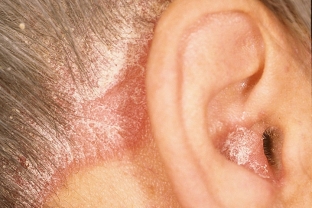Seborrhea of the scalp often becomes a seasonal phenomenon: for example, dandruff may appear in connection with the beginning of the cold autumn season or, conversely, after returning from vacation in hot countries. Patients come to the doctor complaining of severe itching of the scalp and, as a rule, the appearance of profuse dandruff, which cannot be corrected by changing the regimen of hair washing or shampooing. The doctor should deal with the causes that led to the development of seborrhea in order to prevent its intensification, often fraught with hair loss.
Causes of scalp seborrhea
The change in the chemical composition of sebum becomes the impetus for the development of seborrhea of the scalp. According to WHO experts, the reasons why this happens can be divided into three large groups:
- hormonal,
- neurogenic,
- immune.
Another important factor that causes scalp seborrhea is increased sebum secretion. All of these factors cause a thickening of the stratum corneum on the head, which causes the skin to itch and peel, swell and become inflamed.
A yeast-like fungus Pityrosporum ovale is considered to be a serious pathogenetic component in this disease. Under normal conditions, this microorganism is part of the microflora of the scalp in almost 90% of the population, it concentrates around the sebaceous glands, as it feeds on secreted sebum. With a change in the chemical composition of the secreted fat, the amount of fungus on the scalp almost doubles, which contributes to the development of itching and inflammation.
If seborrhea develops according to the so-called dry type, then it is manifested by abundant dandruff and brittle brittle hair, and oily seborrhea is disturbed by dandruff in the form of yellowish plaques and untidy strands of hair stuck together. In any case, seborrhea of the scalp provokes hair loss – up to persistent baldness, and therefore requires timely treatment.

Hormonal causes of scalp seborrhea
Seborrhea of the scalp often develops against the background of hormonal fluctuations – it usually occurs in adolescents during puberty, in pregnant women, in perimenopausal women, sometimes even before the onset of menstruation.
Specialists recommend not to forget about the patient's hereditary predisposition to the development of seborrhea of the scalp, which you should definitely ask the patient at the reception. In addition, when taking an anamnesis, you should find out everything about possible diseases associated with metabolic disorders, with endocrine pathologies.
If necessary, additional studies should be ordered to rule out the connection of seborrhea of the scalp, for example, with the presence of diabetes mellitus, diseases of the thyroid gland or gonads.
"Causes of gray hair and treatment of gray hair"
Neurogenic and immune causes of scalp seborrhea
The appearance of seborrhea of the scalp is often noted against the background of stress, lack of sleep, and some diseases of the nervous system. For example, patients with Parkinson's disease or paralysis of the body almost always have some degree of seborrhea.
Seborrhea is common in most immunocompromised patients. Moreover, seborrhea of the scalp affects many patients who have had severe infectious diseases, after which the body's defenses have sharply decreased.
In addition to purely medical reasons for the development of seborrhea of the scalp, the doctor should always be aware of other factors that can provoke skin irritation. We are talking about poor-quality hair coloring, the use of aggressive hairdressing procedures, diet violations, the influence of external adverse factors.







Add a comment